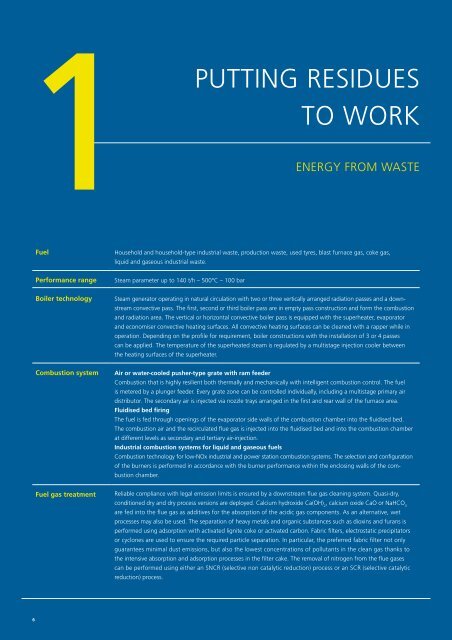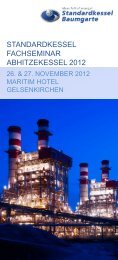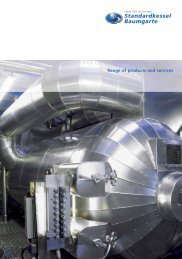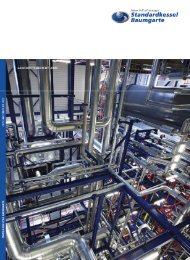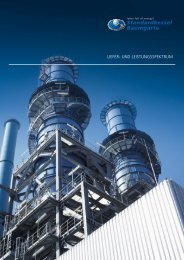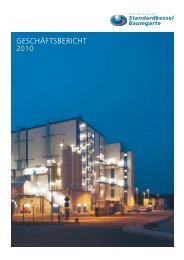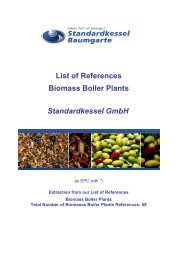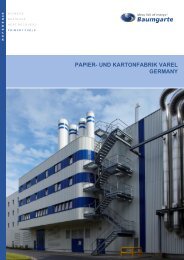Range of Products and Services - Standardkessel Baumgarte
Range of Products and Services - Standardkessel Baumgarte
Range of Products and Services - Standardkessel Baumgarte
You also want an ePaper? Increase the reach of your titles
YUMPU automatically turns print PDFs into web optimized ePapers that Google loves.
1<br />
6<br />
PUTTING RESIDUES<br />
TO WORK<br />
ENERGY FROM WASTE<br />
Fuel Household <strong>and</strong> household-type industrial waste, production waste, used tyres, blast furnace gas, coke gas,<br />
liquid <strong>and</strong> gaseous industrial waste.<br />
Performance range Steam parameter up to 140 t/h – 500°C – 100 bar<br />
Boiler technology Steam generator operating in natural circulation with two or three vertically arranged radiation passes <strong>and</strong> a down-<br />
stream convective pass. The first, second or third boiler pass are in empty pass construction <strong>and</strong> form the combustion<br />
<strong>and</strong> radiation area. The vertical or horizontal convective boiler pass is equipped with the superheater, evaporator<br />
<strong>and</strong> economiser convective heating surfaces. All convective heating surfaces can be cleaned with a rapper while in<br />
operation. Depending on the pr<strong>of</strong>ile for requirement, boiler constructions with the installation <strong>of</strong> 3 or 4 passes<br />
can be applied. The temperature <strong>of</strong> the superheated steam is regulated by a multistage injection cooler between<br />
the heating surfaces <strong>of</strong> the superheater.<br />
Combustion system Air or water-cooled pusher-type grate with ram feeder<br />
Fuel gas treatment<br />
Combustion that is highly resilient both thermally <strong>and</strong> mechanically with intelligent combustion control. The fuel<br />
is metered by a plunger feeder. Every grate zone can be controlled individually, including a multistage primary air<br />
distributor. The secondary air is injected via nozzle trays arranged in the first <strong>and</strong> rear wall <strong>of</strong> the furnace area.<br />
Fluidised bed firing<br />
The fuel is fed through openings <strong>of</strong> the evaporator side walls <strong>of</strong> the combustion chamber into the fluidised bed.<br />
The combustion air <strong>and</strong> the recirculated flue gas is injected into the fluidised bed <strong>and</strong> into the combustion chamber<br />
at different levels as secondary <strong>and</strong> tertiary air-injection.<br />
Industrial combustion systems for liquid <strong>and</strong> gaseous fuels<br />
Combustion technology for low-NOx industrial <strong>and</strong> power station combustion systems. The selection <strong>and</strong> configuration<br />
<strong>of</strong> the burners is performed in accordance with the burner performance within the enclosing walls <strong>of</strong> the com-<br />
bustion chamber.<br />
Reliable compliance with legal emission limits is ensured by a downstream flue gas cleaning system. Quasi-dry,<br />
conditioned dry <strong>and</strong> dry process versions are deployed. Calcium hydroxide Ca(OH) 2 , calcium oxide CaO or NaHCO 3<br />
are fed into the flue gas as additives for the absorption <strong>of</strong> the acidic gas components. As an alternative, wet<br />
pro cesses may also be used. The separation <strong>of</strong> heavy metals <strong>and</strong> organic substances such as dioxins <strong>and</strong> furans is<br />
performed using adsorption with activated lignite coke or activated carbon. Fabric filters, electrostatic precipitators<br />
or cyclones are used to ensure the required particle separation. In particular, the preferred fabric filter not only<br />
guarantees minimal dust emissions, but also the lowest concentrations <strong>of</strong> pollutants in the clean gas thanks to<br />
the intensive absorption <strong>and</strong> adsorption processes in the filter cake. The removal <strong>of</strong> nitrogen from the flue gases<br />
can be performed using either an SNCR (selective non catalytic reduction) process or an SCR (selective catalytic<br />
re duction) process.


